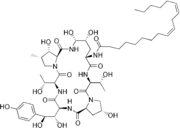
Echinocandin
Encyclopedia

Antifungal drug
An antifungal medication is a medication used to treat fungal infections such as athlete's foot, ringworm, candidiasis , serious systemic infections such as cryptococcal meningitis, and others...
s that inhibit the synthesis of glucan
Glucan
A glucan molecule is a polysaccharide of D-glucose monomers linked by glycosidic bonds.Many beta-glucans are medically important.-Types:The following are glucans:-Alpha:...
in the cell wall
Cell wall
The cell wall is the tough, usually flexible but sometimes fairly rigid layer that surrounds some types of cells. It is located outside the cell membrane and provides these cells with structural support and protection, and also acts as a filtering mechanism. A major function of the cell wall is to...
, probably via noncompetitive inhibition of the enzyme
Enzyme
Enzymes are proteins that catalyze chemical reactions. In enzymatic reactions, the molecules at the beginning of the process, called substrates, are converted into different molecules, called products. Almost all chemical reactions in a biological cell need enzymes in order to occur at rates...
1,3-β glucan synthase and are thus called penicillin of antifungals (a property shared with papulacandins). Beta glucans are polymers which, linked in their tens of thousands, make up cell wall membranes. Some other examples are cellulose and starches in the plant world, and glycogen and dextran in the animal world, made from alpha glucans.
Uses
It is used in candidiasisCandidiasis
Thrush redirects here. For the hoof infection see Thrush .Candidiasis or thrush is a fungal infection of any of the Candida species , of which Candida albicans is the most common...
and aspergillosis
Aspergillosis
Aspergillosis is the name given to a wide variety of diseases caused by fungi of the genus Aspergillus. The most common forms are allergic bronchopulmonary aspergillosis, pulmonary aspergilloma and invasive aspergillosis. Most humans inhale Aspergillus spores every day...
.
They are fungicidal against some yeast
Yeast
Yeasts are eukaryotic micro-organisms classified in the kingdom Fungi, with 1,500 species currently described estimated to be only 1% of all fungal species. Most reproduce asexually by mitosis, and many do so by an asymmetric division process called budding...
s (most species of Candida
Candida (genus)
Candida is a genus of yeasts. Many species are harmless commensals or endosymbionts of animal hosts including humans, but other species, or harmless species in the wrong location, can cause disease. Candida albicans can cause infections in humans and other animals, especially in immunocompromised...
, but not against Cryptococcus
Cryptococcus
Cryptococcus is a genus of fungus. Species grow in culture as yeasts. The perfect forms or teleomorphs of Cryptococcus species are filamentous fungi in the genus Filobasidiella...
, Trichosporon
Trichosporon
Trichosporon is a genus of anamorphic fungi in the family Trichosporonaceae. All species of Trichosporon are yeasts with no known teleomorphs . Most are typically isolated from soil, but several species occur as a natural part of the skin microbiota of humans and other animals...
and Rhodotorula
Rhodotorula
Rhodotorula is a pigmented yeast, part of the Basidiomycota phylum, quite easily identifiable by distinctive orange/red colonies when grown on SDA . This distinctive colour is the result of pigments that the yeast creates to block out certain wavelengths of light that would otherwise be damaging...
), fungistatic against some mold
Mold
Molds are fungi that grow in the form of multicellular filaments called hyphae. Molds are not considered to be microbes but microscopic fungi that grow as single cells called yeasts...
s (Aspergillus
Aspergillus
Aspergillus is a genus consisting of several hundred mold species found in various climates worldwide. Aspergillus was first catalogued in 1729 by the Italian priest and biologist Pier Antonio Micheli...
, but not Fusarium
Fusarium
Fusarium is a large genus of filamentous fungi widely distributed in soil and in association with plants. Most species are harmless saprobes, and are relatively abundant members of the soil microbial community. Some species produce mycotoxins in cereal crops that can affect human and animal health...
and Rhizopus
Rhizopus
Rhizopus is a genus of common saprobic fungi on plants and specialized parasites on animals. They are found on a wide variety of organic substrates, including "mature fruits and vegetables", faeces, jellies, syrups, leather, bread, peanuts and tobacco. Some Rhizopus species are opportunistic agents...
), and modestly or minimally active active against dimorphic fungi (Blastomyces
Blastomyces
Blastomyces is a fungal genus responsible for the medical condition blastomycosis.The most well known species of the genus is Blastomyces dermatitidis. B. dermatitidis is a dimorphic fungal pathogen, found primarily in the Mid-West and Northern United States and Canada...
and Histoplasma
Histoplasma
Histoplasma is a genus of dimorphic fungi commonly found in bird and bat fecal material. Histoplasma contains a few species, including—H. capsulatum—the causative agent of histoplasmosis; and Histoplasma capsulatum var. farciminosum , causing epizootic lymphangitis in horses...
). These have some activity against the spores of the fungus Pneumocystis carinii.
History
The present day clinically used echinocandins are semisynthetic pneumocandins, which are chemically lipopeptide in nature, consisting of large cyclic (hexa)peptides linked to a long chain fatty acid. Discovery of echinocandins stemmed from studies on papulacandins isolated from a strain of Papularia sphaerosperma (Pers.), which were liposaccharide, i.e., fatty acid derivatives of a disaccharide which also blocked the same target, 1,3-β glucan synthase, and had action only on Candida spp. (narrow spectrum). Screening of natural products of fungal fermentation in the 1970s led to the discovery of echinocandins, a new group of antifungals with broad range activity against Candida spp. One of the first echinocandins of the pneumocandin type, discovered in 1974, echinocandin BEchinocandin B
Echinocandin B is a lipopeptide with antifungal activity....
, could not be used clinically due to risk of high degree of hemolysis. Screening semisynthetic analogs of the echinocandins gave rise to cilofungin
Cilofungin
Cilofungin is the first clinically applied member of the Echinocandin family of antifungal drug. It was derived from a fungus in the genus Aspergillus. It accomplishes this by interfering with an invading fungus' ability to synthesize the cell wall ....
, the first echinofungin analog to enter clinical trials, in 1980, which was later withdrawn for a toxicity presumably due to the solvent system needed for systemic administration. The semisynthetic pneumocandin analogs of echinocandins were later found to have the same kind of antifungal activity, but low toxicity. The first approved of these newer echinocandins was caspofungin
Caspofungin
Caspofungin is an antifungal drug, the first of a new class termed the echinocandins from Merck & Co., Inc. It shows activity against infections with Aspergillus and Candida, and works by inhibiting the enzyme β-D-Glucan synthase and thereby disturbing the integrity of the fungal cell wall...
, and later micafungin and anidulafungin
Anidulafungin
Anidulafungin or Eraxis is an antifungal drug originally manufactured and submitted for FDA approval by Vicuron Pharmaceuticals. Pfizer acquired the drug upon its acquisition of Vicuron in the fall of 2005. Pfizer gained approval by the Food and Drug Administration on February 21, 2006; it was...
were also approved. All these preparations so far have low oral bioavailability, so must be given intravenously only. Echinocandins have now become one of the first line treatments for Candida before the species are identified, and even as antifungal prophylaxis in hematopoietic stem cell transplant patients.
Advantages
Advantages of echinocandins:- broad range (especially against all CandidaCandida (genus)Candida is a genus of yeasts. Many species are harmless commensals or endosymbionts of animal hosts including humans, but other species, or harmless species in the wrong location, can cause disease. Candida albicans can cause infections in humans and other animals, especially in immunocompromised...
), thus can be given empirically in febrile neutropenia and stem cell transplant - can be used in case of azole-resistant Candida or use as a second line agent for refractory aspergillosis
- long half life (polyphasic elimination: alpha phase 1–2 hours + beta phase 9–11 hours + gamma phase 40–50 hours)
- low toxicity: only histamine release (3%), fever (2.9%), nausea and vomiting (2.9%), and phlebitis at the injection site (2.9%), very rarely allergy and anaphylaxis
- not an inhibitor, inducer, or substrate of the cytochrome P450 system, or P-glycoprotein, thus minimal drug interactions
- lack of interference from renal failure and hemodialysis
- no dose adjustment is necessary based on age, gender, race
- better (or no less effective) than amphotericin B and fluconazole against yeast infections
Disadvantages
Disadvantages of echinocandins:- embryotoxic (category C) thus cannot be used in pregnancy
- needs dose adjustment in liver disease
- poor ocular penetration in fungal endophthalmitis
Interference
Caspofungin has some interference with ciclosporinCiclosporin
Ciclosporin , cyclosporine , cyclosporin , or cyclosporin A is an immunosuppressant drug widely used in post-allogeneic organ transplant to reduce the activity of the immune system, and therefore the risk of organ rejection...
metabolism, and micafungin has some interference with sirolimus
Sirolimus
Sirolimus , also known as rapamycin, is an immunosuppressant drug used to prevent rejection in organ transplantation; it is especially useful in kidney transplants. A macrolide, sirolimus was first discovered as a product of the bacterium Streptomyces hygroscopicus in a soil sample from Easter...
(rapamycin), but anidulafungin needs no dose adjustments when given with ciclosporin, tacrolimus
Tacrolimus
Tacrolimus is an immunosuppressive drug that is mainly used after allogeneic organ transplant to reduce the activity of the patient's immune system and so lower the risk of organ rejection...
or voriconazole
Voriconazole
Voriconazole is a triazole antifungal medication that is generally used to treat serious, invasive fungal infections. These are generally seen in patients who are immunocompromised, and include invasive candidiasis, invasive aspergillosis, and certain emerging fungal infections.-Invasive...
.
Examples

- pneumocandins (cyclic hexapeptides linked to a long chain fatty acid):
- Echinocandin BEchinocandin BEchinocandin B is a lipopeptide with antifungal activity....
not clinically used, risk of hemolysis - CilofunginCilofunginCilofungin is the first clinically applied member of the Echinocandin family of antifungal drug. It was derived from a fungus in the genus Aspergillus. It accomplishes this by interfering with an invading fungus' ability to synthesize the cell wall ....
withdrawn from trials due to solvent toxicity - CaspofunginCaspofunginCaspofungin is an antifungal drug, the first of a new class termed the echinocandins from Merck & Co., Inc. It shows activity against infections with Aspergillus and Candida, and works by inhibiting the enzyme β-D-Glucan synthase and thereby disturbing the integrity of the fungal cell wall...
(trade name Cancidas, Merck) - Micafungin (FK463) (trade name Mycamine, Astellas Pharma.)
- AnidulafunginAnidulafunginAnidulafungin or Eraxis is an antifungal drug originally manufactured and submitted for FDA approval by Vicuron Pharmaceuticals. Pfizer acquired the drug upon its acquisition of Vicuron in the fall of 2005. Pfizer gained approval by the Food and Drug Administration on February 21, 2006; it was...
(VER-002, V-echinocandin, LY303366) (trade name Eraxis, Pfizer)
- Echinocandin B

